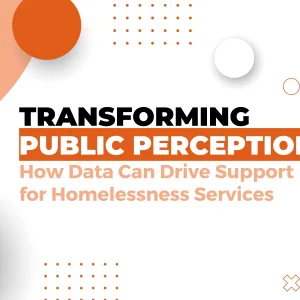Case Management for Human Services Before and After COVID-19
Human services organizations of all sizes rely heavily on case management to improve outcomes for their clients. As stated in the pre-pandemic Salesforce Nonprofit Trends Report, “demand for more nonprofit programs and services is rising, as the world is threatened by climate change, natural and human-made disasters, humanitarian crises, political chaos, food insecurity, and so much more.” Since COVID-19 has impacted communities globally, the need for case management to support increasing at-risk populations worldwide has only grown.
What is Case Management?
Since case management is practiced across all health and human services settings, its definition varies based on the program goals and outcomes. The National Association of Social Workers (NASW) defines case management as “a process to plan, seek, advocate for, and monitor services from different social services or health care organizations and staff on behalf of a client.”
This definition is relevant for all human services populations where case management is practiced. The following is a list of some of the areas where case managers work with clients:
- Aging
- Behavioral health (mental health and substance use)
- Child welfare and other youth and family oriented services
- Corrections
- Disabilities (cognitive, developmental, physical, and psychiatric)
- Education (early childhood through university; lifelong learning programs)
- Employee assistance
- Health care (including, but not limited to: ambulatory, acute, and rehabilitative care; disease-specific services; maternal health; palliative and hospice care; and public and private health insurance programs)
- Housing
- Immigrant and refugee support services
- Income support services
- Long-term services and support
- Services for veterans and active duty military personnel
- Tribal services
According to NASW the primary goal of case management is to improve client well-being by providing and coordinating high-quality services to individuals with multiple complex needs.
Guiding Principles of Case Management
There are many case management principles that vary across human services sectors, but these four stand out as best practices that span all service areas according to NASW, Commission for Case Management Certification, and the Global Social Service Workforce Alliance:
- Person-centered services: Case managers’ first duty is to their participants, ensuring that they are involved in all goal planning and tailoring services to meet their individual needs.
- Client-case manager relationship: The working relationship between the case manager and participant is key in helping the client reach their goals.
- Strengths perspective: Case managers focus on the strengths and resources of the client. Strengths should be built upon and integrated into the case management process to help inform decisions about actions to be taken to reach their goals.
- Collaboration: The social work case manager does not work in isolation. Collaboration with other social workers, other disciplines, and other organizations is integral to the case management process.
Example of Guiding Principles in Action
A local non-profit housing organization wants to help a new client Janet Young, a single mother of two children. Janet’s family of three was recently evicted from their apartment due to several missed rent payments. She not only needs safe, stable housing for her family, but she has been struggling to put food on the table as she has been out of work for the past six months.
Janet’s challenge to stay employed is a result of several factors. First, she struggles emotionally due to having been through two abusive relationships. Second, Janet does not have access to affordable child care. Third, she does not have a high school diploma, which is required by many prospective employers.
Case Manager, Alicia Gomez, steps in to help Janet address these diverse needs. Alicia helps Janet obtain SNAP (Supplemental Nutrition Assistance Program) for food assistance, and also helps Janet join SNAP’s state child care voucher program to cover child care costs. Finally, Alicia and Janet work together to set up a plan for Janet to attain her GED online.
In addition, Alicia finds Janet temporary housing at one of the organization’s shelter sites, where Janet and her children can stay until she has enough money saved for a new place. Alicia also pairs Janet with a trauma therapist. Alicia and the therapist work together to ensure Janet is getting all of the support she needs to be successful.
During their time exploring Janet’s strengths, Janet expresses her love of children and ease of working with them and gaining their trust. She explains her strong interest in early childhood education, so Janet and Alicia agree to do research on what it takes to attain an early childhood teaching certificate as a step towards a new career.
Janet and Alicia’s working relationship is just one example of how the case management process addresses complex client needs through quality services. The guiding principles of case management are demonstrated when Alicia works together with Janet to come up with a plan to achieve her goals, helps Janet identify and build upon her strength in working with children, and collaborates with the trauma therapist to ensure Janet is receiving services needed to address her emotional trauma.
Core Functions of Case Managers
Case managers work across disciplines, but the steps that they take to help their clients attain desired outcomes are similar across the board. Whether a case manager works with families in home-based settings, children in schools, adults in private practices, incarcerated individuals, or chronically-ill seniors in hospitals, a case manager typically follows the steps below throughout a case management process.
- Intake: The purpose of this initial meeting is to gather basic demographics and any other information needed prior to enrolling a participant in a program. Eligibility screening, client engagement, and addressing immediate needs are all done during the intake process. If the client is eligible for—and wants to move forward with—program services, they can move on by completing an initial assessment.
- Assessment: An initial assessment is carried out with the client to determine their needs and strengths in different life areas, such as income, employment, childcare, healthcare, and transportation. This comprehensive process allows the case manager and client to identify areas that need improvement in order to optimize client functioning.
- Service Planning: In this step of the process, client goals are established and prioritized, and then a plan to achieve those goals is created. Oftentimes the service plan will include target dates, responsible parties, and the steps that must be taken to achieve each goal.
- Service Provision: Individual or group services are provided to the client by the case manager in order to help the client achieve their goals. Services may include job search assistance or assistance with finding healthcare providers.
- Referrals: In order to address client-specific needs, referrals to other programs within the current organization or to outside agencies are often necessary.
- Assessment: Re-assessment is done to ensure the client is making progress on areas identified as needs in the initial assessment. This is completed at predetermined intervals throughout the case management journey.
- Program Exit: The client exits the program once they have achieved all goals in the service plan, and the case manager and client both agree that the client is ready to exit the program.
Impacts of COVID-19 on Case Management
As with all human services, the COVID-19 pandemic has greatly changed the way case managers engage with their clients. According to the Wolters Kluwer Public Health Emergency Collection “the COVID-19 global pandemic crisis has brought an unprecedented challenge to professional case managers.” Case managers rely on strong relationships with their clients in order to achieve positive outcomes. Without the ability to meet face-to-face, case managers have had to quickly adapt to using technology to reach their clients and establish a trusting relationship.
For example, training their clients on how to use video chat and telehealth tools has been a challenge as digital access and digital literacy is severely lacking in many underserved populations. Furthermore, data collection mechanisms have had to change—handing a client paperwork to fill out is no longer an option. Case managers have had to adapt to using new technology to collect basic information through text messaging and online portals. Case managers use their numerous skills and resources to help all of their clients access the technology needed to reach their goals. So, although this has been a difficult year, new opportunities for innovation and partnerships have been created that will last long into the future of case management for human services.
Using Exponent Case Management
Exponent Case Management is next generation case management designed for your Human Services agency. Ideal for case workers, program managers, and agency leaders, the application is a fully-featured, customizable solution with intake, assessment, service tracking, case records, outcomes reporting, referral tracking, and more. Built on the Salesforce platform, Exponent Case Management allows you to directly connect your program data to your impact with funder and performance reporting at your fingertips.
Is Exponent Case Management Right for Your Human Services Agency?
The app is robust and serves range of nonprofit organizations and agencies with unique needs including:
- Workforce Development. Seamless integration with Salesforce means access to key data such as assessment, training, retention, and engagement, all with robust reporting.
- Homelessness. Track shelter and transitional housing, as well as provide comprehensive case management services. Track progress toward self-sufficiency over time.
- Emergency Services. From the immediate crisis to long-term support, track individual outcomes for your disaster relief, food bank, rapid-rehousing programs, and more.
- Child and Family Services. General case management, foster care, after school programs: see a complete participant dashboard and stay focused on providing quality services.
- Reentry. Track participants’ assessment, plans, and services from their pre-release reentry plan to post-release services to attaining self-sufficiency.
- Senior Services. Track everything you need to do in one place to provide comprehensive services to seniors to help them reduce hospital admissions and age in place.
- Community Collaborations. Collaborate across organizations to ensure clients receive complimentary services. Standardize outcomes and indicators, remaining focused on common goals.
- Affiliative Networks. Join a network of charitable organizations, clubs, and networks such as United Ways, YMCA, Boys and Girls Clubs
Case management can greatly improve lives. Case managers not only help with immediate needs during a crisis, but provide education, ongoing support, and advocacy to help clients improve their quality of life. To help organizations serving some of the most vulnerable populations during the pandemic, Exponent Partners released Exponent Case Management accelerators for Workforce Development programs as well as organizations requiring Homelessness Information Management System (HMIS) integrations.
Interested in seeing the Exponent Case Management app in action? Register for the next live demo and contact us today.



